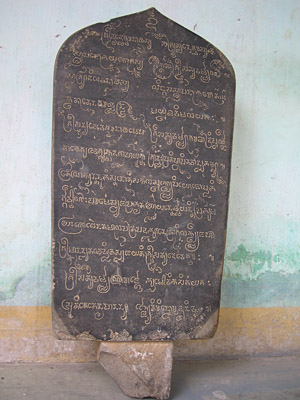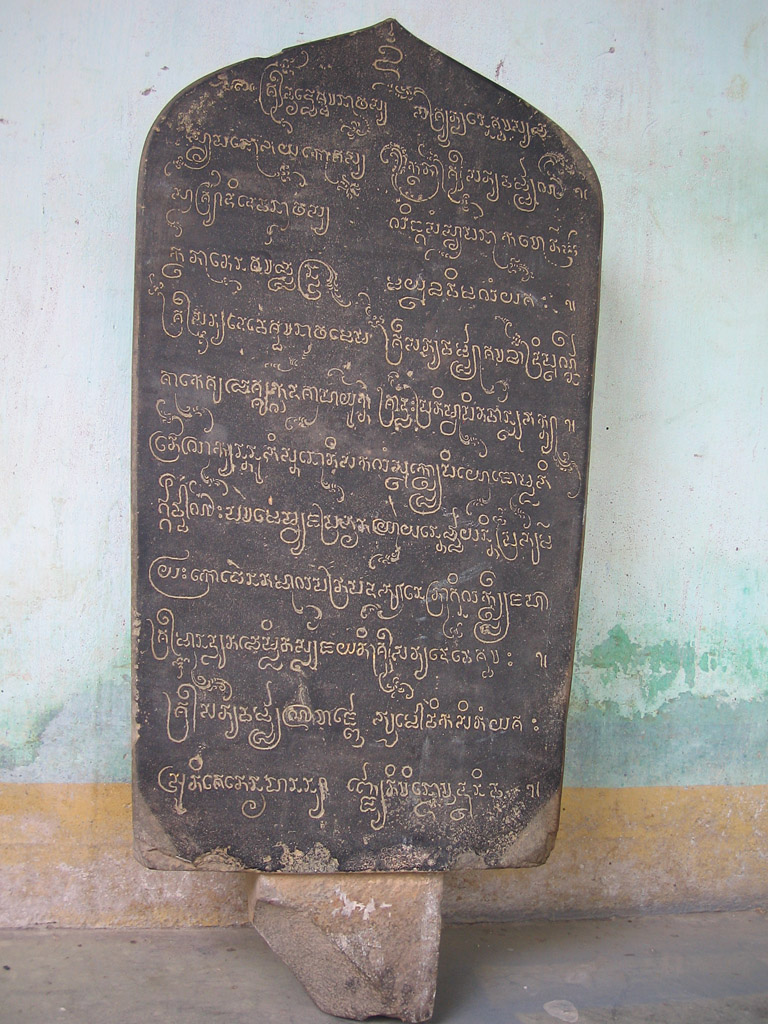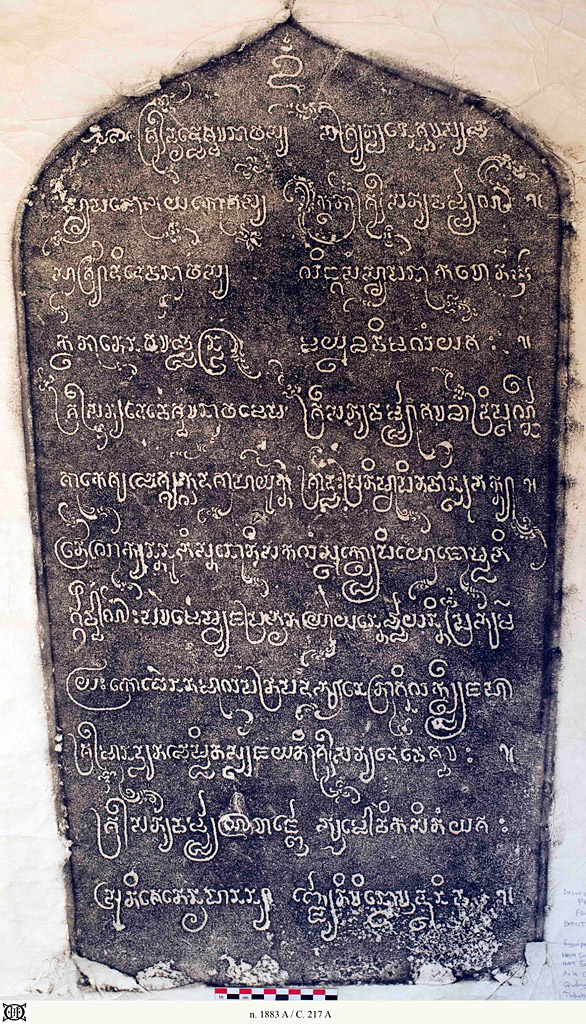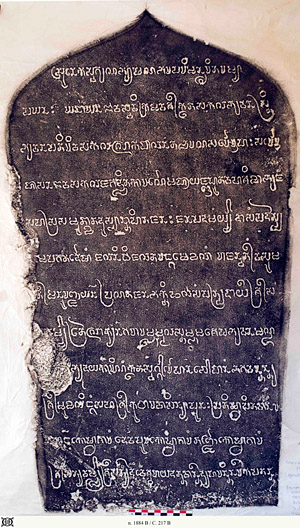Corpus of the Inscriptions of Campā






C. 217 Stela inscription of Phươc Thiện
Please note: you are reviewing a preprint version of this publication. Contents here may change significantly in future versions. Scholars with specific interests are urged to consult all cited bibliography before using our texts and translations or drawing other significant conclusions.
Text The stela is engraved on two faces. Face A bears an incipit and 12 lines; face B also bears 12 lines. Both faces are written in Sanskrit.
Date 10 waxing Śuci (= Jyeṣṭha), 705 Śaka (16 May, 783 CE).
Origin Village of Phươc Thiện (Phước Sơn, Ninh Phước, Ninh Thuân, Vietnam).
According to our earlier publication ECIC I: 351 (where we based ourselves on the volume title of the publication of Nguyễn Duy Tỳ & Lê Minh Phong 1993), the stela was discovered in 1993, in a rice field belonging to the village (thôn) of Phước Thiện, near the commune (xã) presently known as Phước Sơn, in the district (huyện) of Ninh Phước, at about 10 KM North-West of the town of Phan Rang. But according to the museum's registers, which were not yet known to us at the time, it was acquired by the BTNT on 15 October 1992. In this light, we must correct our previous statement. The stela was first observed at the BTNT in 1993, as mentioned in Nguyễn Duy Tỳ & Lê Minh Phong 1993, which is also the first scholarly publication on this inscription, and it was observed there again by William A. Southworth in 2004 as well as by Bertrand Porte in 2008 (cf. ECIC I: 351). We identified the stela in the store room of the museum in 2009, as the one bearing inventory number 1440/Đ.13 (see ECIC III: 466).
Edition(s) First published in ECIC I, whence the present edition, with one correction based on our publication ECIC III.
Facsimiles
- Estampage: EFEO n. 1883
- Estampage: EFEO n. 1884
The following text was edited by Arlo Griffiths.
Face A.
Face B.
V udūn ◇ read uḍūn. — 9 °rohana° ◇ read °rohaṇa°.
Translations
English
I. The installation of a sheath for both of them, Śrī Vṛddheśvaranātha and Śrī Utpanneśvara, has been carried out by Śrī Satyavarman.
II. This installation of the liṅga of the Primordial God (Śiva), carried out by him (Satyavarman), has produced glory immaculate like the rays of the moon in autumn.
III. This pious Śrī Satyavarman has, with great devotion, established Śrī Satyadeveśvaranātha in the elapsed (pūrṇa) Śaka [year] 705 (5 [arrows], 0 [ether], 7 [mountains]), on the tenth day of the waxing [fortnight] (śukladaśāhayukte) of [the month] Śuci.
IV. The Un-born (Śiva), who spans the totality of the triple world with his eight bodies, even though he is subtle; the lord (prabhu) to whom the gods (gīrvāṇa) — the Supreme (Viṣṇu) and the Un-born (Brahmā) and so forth — render homage; he who has killed in wrath the son of Lakṣmī (i.e. Kāma) with the fire of his eye that is situated at the place of the tilaka (tamālapatra-pada-bhū); this illustrious Śrī Satyadeveśvara, whose workings are miraculous, is victorious.
V. The glory of the king Śrī Satyavarman, spread out over the earth, surpasses [that of] other kings, as the light of the moon [that of] the stars.
Just as the Cloud (i.e. Indra), his beautiful limbs are rendered very slow by the weight of the ornaments which are his numerous vitues; like the Lord of the Three World (i.e. Viṣṇu as Trivikrama), he has subdued the entire world by his valor (vikrama); like the one whose seat is a lotus (i.e. Brahmā), he has lotus-feet to which all kings bow down; he is the benefactor of the entire world; he has radically exterminated (samutkhāta), with the thousand arms that are the flames (hutavaha-śikhā) of the great sacrifices (that he had performed), the ennemies (ahita-jana) of evil heart (duḥsvānta); he causes joy to the Earth, abode of the abundance [which is the result] of the customs of the land [being carefully observed], whose defaults have fled (when he threatened them), who has for belt the waves of the ocean, being governed by a good king; he grants to those who bow before him the abundance of fruits of their devotion; [this] Śrī Satyavarman has also (tu) reinstalled, with the Lady who abides in Kuṭhāra, the Lord Śrī Mukhaliṅga, who was the base-pillar at the beginning [of the construction] of the City of the Three World, who provides the prosperity of the entire circle of worlds, and who has created a ladder to climb to heaven.
Śrī Satyavarman has given to Śrī Satyadeveśvara the silo of [?]ṅ, the silo of Devapura, the silo of Tañjo. May those who steal it fall in hell!
French
I. L’installation d’un étui pour les deux, Śrī Vṛddheśvaranātha et Śrī Utpanneśvara, a été exécutée par Śrī Satyavarman.1
II. Cette installation du linga du Dieu Primordial (Siva), exécutée par lui (Satyavarman), a produit une gloire immaculée comme les rayons de la lune en automne.
III. Ce pieux Śrī Satyavarman a établi, avec une grande dévotion, Śrī Satyadeveśvaranātha en [l’an] évolu (pūrṇa) śaka 705 (5 [flèches], 0 [éther], 7 [monts]), le dixième jour [de la quinzaine] claire (śukladaśāhayukte) [du mois] de Suci.
IV. Le Non-né (Siva), qui étend l’intégralité du triple monde avec ses huit corps, bien qu’il soit subtil ; le maître (prabhu) à qui ces dieux (gīrvāṇaḥ) — à commencer par le Suprême (Viṣṇu) et le Non-né (Brahmā) — rendent hommage ; lui qui, en fureur, a tué le fils de Lakṣmī (c.-à-d. Kāma) par le feu de son oeil qui se trouve à l’endroit du tilaka (tamālapatra-pada-bhū) ; ce fortuné Śrī Satyadevesvara, à la geste merveilleuse, est victorieux.
V. La gloire du roi Śrī Satyavarman, épanouie sur la terre, dépasse [celle des] autres rois, comme la lumière de la lune [celle des] étoiles.
Tel le Nuage (c.-à-d. Indra), ses beaux membres sont rendus très lents par le poids des ornements que sont ses multiples vertus ; tel le Seigneur des Trois Mondes (c.-à-d. Viṣṇu en tant que Trivikrama), il a soumis le monde entier par sa valeur (vikrama) ; tel Celui dont le Siège est un lotus (c.-à-d. Brahmā), il a des poids-lotus devant lesquels tous les rois se prosternent ; il est le bienfaiteur du monde entier ; il a exterminé radicalement (samutkhāta), avec les mille bras que sont les flammes (hutavaha-śikhā) des grands sacrifices (qu’il faisait exécuter), les ennemis (ahita-jana) au coeur mauvais (duḥsvānta) ; il gratifie la terre, demeure de la plénitude [qui est le résultat] des moeurs du pays, [la terre] dont les défauts se sont enfuis (quand il les menaçait), qui a pour ceinture les vagues de l’océan, qui est gouvernée par un bon roi ; il accorde à ceux qui se prosternent [devant lui] la plénitude des fruits de leur dévotion ; [ce] Śrī Satyavarman a également (tu) réinstallé, avec la Dame qui demeure à Kuṭhāra, le Seigneur Śrī Mukhaliṅga qui était le pilier de base lors du début [de la construction] de la Ville des Trois Mondes, qui fait la prospérité du cercle entier des terres et qui a créé une échelle pour monter au ciel.
Śrī Satyavarman a donné à Śrī Satyadevesvara le silo de [?]n, le silo de Devapura, le silo de Tañjo. Que ceux qui s’en saisissent tombent dans l’enfer.
Secondary Bibliography
Notes
- Suivant la correction proposée dans ECIC III: 298. Notre traduction de 2007 était: "L’installation de Śrī Vṛddheśvaranātha avec Śrī Utpanneśvara, [et] d'un étui pour chacun d'eux, a été exécutée par Śrī Satyavarman."


